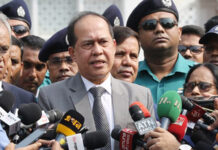Crime Spiral in CHT: Conflicting claims bury ‘why’ in hills

Fear has gripped Chattogram Hill Tracts (CHT), as murders are taking place one after another due to alleged inter-party conflicts between local armed groups.
There has been a spate of killings — 72 in total — in the last one-and-a-half years, along with 53 abductions during the same period, according to security force and intelligence sources.
Investigators believe it is the outcome of internal strife between the regional political groups to establish supremacy in the hill tracts.
Most of the persons killed were members of the four regional parties — Parbatya Chattagram Jana Sanghati Samiti (PCJSS)- Santu Larma, PCJSS- MN Larma, United People’s Democratic Front (UPDF)- Main and UPDF – Democratic.
The latest incident happened on May 25 when former vice president of AL’s Bandarban town unit Chaw Thowai Mong Marma was found dead in a remote area of Kuhalong, three days after he was abducted from his farmhouse.
Another shocking incident was the brazen Baghaichhari brushfire, one of the biggest attacks since the CHT peace accord.
On March 18, eight people, including two polling officials and four Ansar personnel, were shot dead by attackers in Baghaichhari upazila, while the victims were returning to the upazila town with polling materials in two cars after discharging their duties at a polling centre during the second phase of the upazila elections.
The brushfire also left 18 others injured.
The Baghaichhari gun attack was the first incident in CHT where government officials came under attack.
Investigators, however, claimed the government officials were not the targets but it was some polling agents of the rival parties in one of the vehicles.
Not only that, Bilaichhari upazila Awami League President Suresh Kanti Tanchangya, 45, was killed a day after the Baghaichhari attack.
The killings, though, were yet to cease. Two more AL men were shot dead back to back on May 18 and May 19 in Rangamati and Bandarban.
The bloody spell of murders took even more political overtones, as 22 political murders took place in 2018.
According to officials in the law enforcement and intelligence agencies, several hundred armed youths working for the two factions of the PCJSS and the two factions of the UPDF are responsible for such killings, along with incidents of extortion and abduction, in the three hill districts — Rangamati, Khagrachhari and Bandarban.
When a member of one group is attacked, retaliatory attacks follow soon after, but none of the groups ever claims responsibility.
Four UPDF members, two PCJSS supporters and two PCJSS (MN Larma) activists were gunned down between January and May.
The violence puts the lives of 16 lakh people in the CHT — which consists of 13,189sqkm and is home to 11 ethnic communities — in danger.
There is a belief that little progress of investigations into such killings encourage criminals.
Rangamati Superintendent of Police Alomgir Kabir said criminals make use of the geographical advantage in the area as the rugged hills make it hard for law enforcement agencies to conduct operations.
“After committing crimes, they [the attackers] go into hiding in the remote areas of the hills and border areas,” he said.
WHY THE VIOLENCE?
Exploring why there had been a flare up in violence, a number of answers came up — rivalry between the regional political groups and their power struggles, use of illegal arms, extortion, no election in CHT regional and district councils, mistrust between locals and Bengali settlers, land issues, and slow implementation of the CHT peace accord.
Some political analysts think that the regional parties gradually losing control over CHT politics could be a reason for the rise in violence.
In the last general elections, no one from the regional parties was elected, with Awami League winning all three seats in CHT districts. The AL-backed candidates also won the majority of the chairman and vice-chairman seats during the upazila elections.
Others, however, put it down to fights over establishing supremacy in the area.
Kujendra Lal Tripura, an AL leader and the incumbent lawmaker from Khagrachhari, blamed the split between regional parties and a violent streak in gaining power, for the current state.
“The peace accord was signed 22 years ago so that people of all communities can live here peacefully. But what we are seeing now? They [the regional parties] themselves got divided and are fighting with each other for establishing supremacy…They are practicing power using illegal arms and killing each other.
“Yet they accuse the government of delaying the implementation of the peace accord. Do they really want peace?” Kujendra Lal asked, adding that the situation was getting complicated.
Some others think the problem of CHT should be seen through the eyes of the locals.
Jyotirindra Bodhipriya Larma, popularly known as Santu Larma, president of the PCJSS, has blamed the government’s “dillydallying” in implementation of the peace accord.
Former chairman of the National Human Rights Commission (NHRC) Prof Mizanur Rahman, said such violence in CHT was ultimately benefiting those who did not want the implementation of the peace accord.
“There has been a struggle for power among the parties regarding who will represent the hill tracts and who will remain close to power… But no matter what the reason is, the fact is killing has been taking place, worsening the human rights situation in the CHT.”
“So it’s a responsibility of the state to find out the liable persons [behind these murders], and bring them under the law,” Prof Mizanur said.
More than 700 people, including political leaders and public representatives, were killed even after signing of the peace accord, according to different political organisations in the CHT.
The CHT Peace Accord was signed in 1997 between the government and the Santu Larma led PCJSS during the first tenure of Prime Minister Sheikh Hasina. The accord brought an end to the bloody conflicts prevalent in the three hill districts.
But a year after the signing of the peace accord, a group of ethnic minority people, led by Prosid Bikash Khisa, formed the UPDF opposing the accord. The party split and UPDF (Democratic), led by Tapan Jyoti Chakma, was formed in November 15, 2017.
The PCJSS also saw a split as some left the organisation in 2007 and formed PCJSS (MN Larma), led by Sudha Sindho Khisa. The rivalry between the two groups began since.









